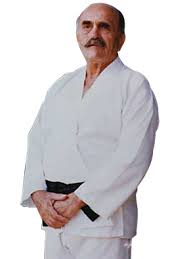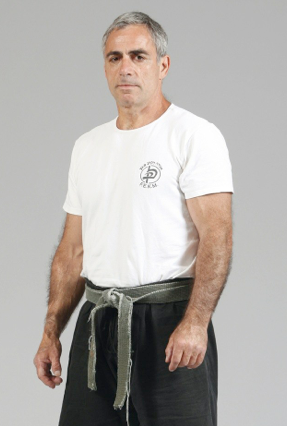
Imi Lichtenfeld, founder of Krav Maga, was born in 1910 in Bratislava, Czechoslovakia. Inspired and encouraged by his father Samuel, former circus acrobat and wrestler, he worked as a physical education teacher, detective and chief instructor of the Departmental Police. Known for his self-defense teaching but also for his many successful arrests, Imi also practiced many sports. He eventually concentrated on gymnastics, wrestling and boxing, actively participating for ten years in many competitions, from which he often emerged victorious, mainly in wrestling.
The Principles of Imi Lichtenfeld
The Krav Maga system developed by Imi, is based on moral and human values, which emphasize the importance of integrity, humility and respect for others. “The very essence of Krav Maga […] is based on several principles:
First, it is a general principle of prevention, by using common sense, and avoiding dangerous situations, for example if you hitchhike, avoid unattractive individuals, avoid walking through a dangerous part of the city;
Second, Krav Maga is based on natural reflexes of the human body;
Third, to defend yourself and attack in the shortest way and from the position you are in, with a minimum of risk-taking for yourself;
Fourth, depending on the situation and the need, depending on the danger posed by the adversary, try to discourage the opponent by speaking;
Fifth, the sensitive points of the human body (eyes, throat, etc.) are used to reach or control the adversary;
Sixth, try to use all the objects within its reach, then the body’s natural weapons;
Seventh, the most realistic principle, no law, no limitations in terms of techniques, no prohibitions, all blows are allowed.”
“Master self-defense so well that you’ll never have to kill anyone.”
Karate Bushido No.195 – October 1992
Tribute to Imi Lichtenfeld

Imi Lichtenfeld passed away on January 8, 1998. The Krav Maga is now orphaned of its creator, and the task lies with us to perpetuate his teaching, his enrichment and especially the spirit of its founder.
“What can we say about the loss of Imi? We can only have the regret that each of our practitioners could not know this man of exception. This regret is all the greater, as the founder of Krav Maga, having created a martial discipline reputedly formidable, Imi, had a strong personality – as we might have suspected – but above all a kindness and a humanity difficult to equal.
Paradox, you will tell me. But is that of course? Does not the search for the most just movement, the most devoid of frills, necessarily bring the author’s mind to clarity free of negative emotions? Unless it is the opposite, and Imi’s exceptionally clear mind did not allow him to conceive of the relentless method of logic that is Krav Maga.
For our role as teachers, I would like to believe that this process works both ways, giving us a little usefulness in the psychological and spiritual evolution of the practitioners under our responsibility.
Richard Douieb, President of the FEKM
Biography

In 1928, Imi wins the Slovak youth wrestling championship
In 1929, Imi won the same wrestling championship but in adults and in two different weight classes, as well as the national boxing championship and an international gymnastics competition
In 1935, a broken rib during training just before a competition in Palestine prevented him from participating. From this event he will draw a principle of safety in practice, contrary to the attitude of winning at all costs: “First, do not be hurt.”
From 1936 to 1940, Imi devoted himself more to the fight. He coaches, practices and wins a dozen medals and prizes. He is considered one of the best European wrestlers. At the same time, he also practices acrobatics and is involved in the dramatic arts. He teaches gymnastics to one of the best theater companies in Czechoslovakia and plays in several productions. During this period, Imi participated in countless clashes and street fighting against anti-Semitic attackers alone or in groups. With the rise of fascism and anti-Semitism, the Nazis spread in Slovakia and the Jews are violently attacked. Imi organizes a group of young Jews, most of them boxing, wrestling or bodybuilding, to stop riots and prevent anti-Semitic gangs from entering the Jewish quarter. He takes part in many fights, which sharpen his awareness of the differences between street fighting and sports competitions.
The first principles of Krav-Maga were born:
- Use reflexes, natural movement
- Simultaneous attack and defense
- Find your resources after a stroke
In 1940, Imi became a problem for local authorities, with the increase of fascism, he was forced to leave his home, his family and his friends. He embarked on the last immigrant ship that managed to escape the Nazis. It was an old river boat called the Pentcho, converted to the transport the hundreds of refugees, fleeing from Central Europe to the promised land Israel (Palestine).
Imi’s odyssey aboard the boat is filled with moving episodes and lasts two years. In the Romanian Delta, the boat is purposely quarantined, in order to starve the passengers. Imi had to jump into the water on numerous occasions, to save fallen passengers or to recover sacks of food, putting his life at risk. On one particular day, he saved a child from drowning, which lead him to develop a serious ear infection which could have cost him his life.
The boat was flat bottomed, thus preventing it from hitting the mines. Along the journey the boiler of the boat exploded, and it ran aground on a Greek island (Kamilanisi). Imi and four of his friends took a rowboat and go to Crete to ask for help. Preferring to ignore the infection of his ear and the protestations from his friends, Imi refused to abandon the oars for a whole day. However despite their heroic efforts, the violent winds capsized their boat and they never reached Crete. On the morning of the 5th day, an English warship retrieved the 5 survivors and took them to Alexandria in Egypt. Imi, between life and death, undergoes several operations in the hospital. The doctors hold little hope for his recovery. The surgeon succeeds in saving his life. After recovering, Imi joined the Czech legion then served under the British army. He was positioned at various points in the Middle East for a year and a half and then received an entry permit for Israel (Palestine).
In 1942, Imi’s friends introduced him to General Sadeh, General of the Hagana (former IDF = Israeli Defensive Forces, Hagana = armed force created in 1920 to organize the defense of the Jews in Palestine) who immediately accepted him into the organization with regard to his talents as a hand-to-hand combatant.
In 1944, Imi began training Israeli fighters. He trained several elite units of the Hagana: Palmach (combat units created in 1941 and which will benefit from the knowledge acquired by all the Jews engaged in WWII for the British), Palyam (commandos marines) as well as police officers. He teaches them fitness for combat, passing individual obstacles, bayonet tactics, sentinel attacks, unarmed melee combat (Krav Maga in Hebrew), swimming, knife fighting, stick.
In 1948, with the birth of the state of Israel and the IDF, Imi became chief instructor in physical education and Krav Maga for the army. He served the IDF for 20 years refining and developing his unique self-defense method. Imi personally trained the best fighters of Israel’s elite units, made up of many generations of Krav Maga instructors, and gained recognition from the highest-ranking army officers. Later, the Ministry of Education gives him state recognition for teaching Krav Maga to civilians. Krav Maga has had to meet the diverse needs of the IDF. It had to be easy to learn and apply, so that a soldier, an office worker or an elite unit fighter could get the required efficiency as quickly as possible as well as being able to implement the techniques despite intense stress.
In the early 1960s, while training a unit of Royal Police guards in Ethiopia, Imi realized that one of the students was really trying to hurt him while showing a defense against a bayonet attack. At the next attack, Imi hits him hard and puts him out of action. This incident makes him reflect on the attitude to be given to students to train in good conditions and prevent injuries: “Do not try to prove who you are”.
In 1964, after withdrawing from the IDF, Imi began adapting Krav Maga to civilian needs. The method is adapted to suit everyone: men and women, young people and adults, anyone who needs to survive an attack with a minimum of risk and damage. To spread his method: Imi establishes 2 training centers in Tel Aviv and Netanya, his hometown, which becomes a center for practitioners of Krav Maga. It adopts the belt system to structure the Krav Maga and ensure a fast and safe progression. During this time, he continued to serve as a consultant and instructor of Krav Maga for the IDF and other security forces.
1972, saw the first civilian instructor training at Wingate Institute. From then on, the method spread to many civilians.
In 1978, Imi created the Israeli Krav Maga Association to extend the method and transmit its values. He remained the president of the association until the end of his life.
In 1981, Krav Maga began to develop in the world.
Right up until his death, Imi continued to develop Krav Maga techniques and concepts. He personally supervised the highest ranking Krav Maga practitioners and spent time with the instructors. Imi controlled the progress and achievements of his students, captivating them with his unique personality and strong sense of humor and passing on his knowledge.
On January 8, 1998, Imi died at the age of 87, keeping his spirit strong even in his last moments.
Thanks to Steve SCHMITT, Krav Maga Lyon, for his research.
